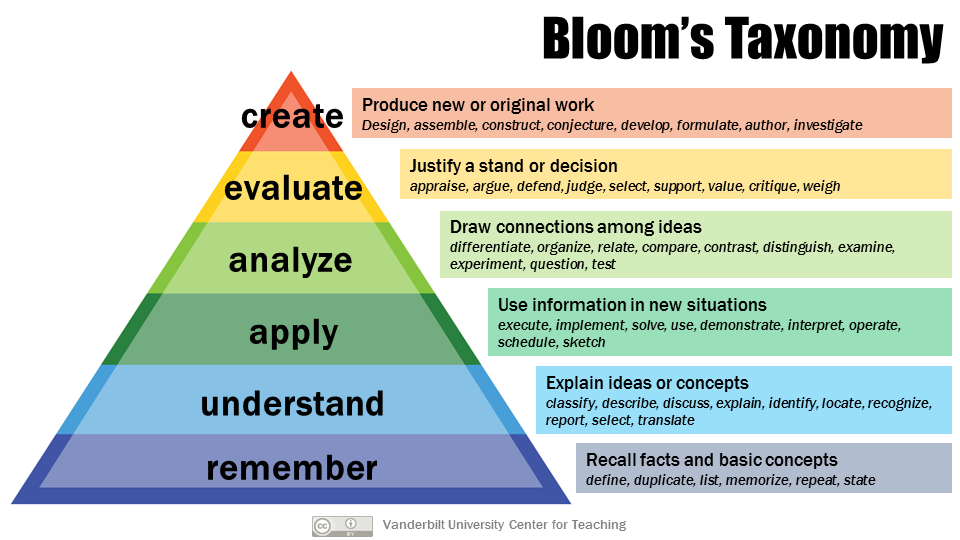Steps toward excellence: The power of learning objectives

In my previous post, I wrote that as this semester draws to a close and the next one approaches, it's time to start thinking about how we move from adequate online teaching done in emergency triage mode to excellent online teaching done from a position of experience and preparation. Next semester is going to be the second iteration of The Big Pivot and as such, the pass that we've received over the last month for doing "mostly OK" work and everyone being fine with that, expires.
Some have told me that this is too much to expect, that it puts too much pressure on instructors. I have two responses to that. First, nobody is expecting second-iteration online teaching to be instantly excellent; I'm only saying that we need to move toward excellent teaching and away from the mindset that "good enough is good enough" -- which was healthy and appropriate in an emergency situation, but not if we are settling in for the long haul. Second, the pressure for excellent online instruction isn't being imposed by me, but by the radically-altered marketplace of higher education and the needs of students. Our students have rolled with the changes of the last month admirably, but now as we enter the second iteration, they are the ones whose futures are at stake. They need more, deserve more, than "good enough" if we have the capability to move toward that ideal.
So I'm starting a series of posts that discuss incremental steps that everyone teaching online can take, one at a time, to get better and start improving what we do. These are based on two sets of experiences. First is my experiences teaching online and hybrid courses myself, which I've been doing since 2016. Second is my recent experience of completing an online course from Quality Matters on "Applying the QM Rubric". I am working toward becoming a certified QM peer reviewer and this was the first course in that process. What I'll be writing about is partially me sharing that learning with the rest of you. I am focusing these posts on steps that:
- Apply to all modalities of instruction, primarily online and hybrid but also face-to-face;
- Require a minimum of new skills or technological competencies; and
- Build on what a lot of us are already doing in our instruction and were doing even before the Big Pivot.
I'm convinced that good teaching is good teaching no matter what the medium, and all faculty teaching right now in this strange situation can improve and move toward excellence by thinking carefully about what makes teaching good, and strengthening the strong links in what they do already.
Full disclosure: I am not teaching right now because of my duties as department chair. But I have been responsible for helping 40+ faculty in my department make this transition over the last month, and a lot of what I'll write here is advice given to those faculty. I'm also teaching in the fall, and at this point nobody really knows how much of Fall 2020 will be online as it is now, so I am definitely going to be putting all this into practice myself.
The centrality of learning objectives
The first incremental step toward excellence is pretty simple:
Write clear, measurable learning objectives for the course at both macro and micro levels.
I've written about the importance of learning objectives before and when I give workshops on designing flipped learning experiences, writing learning objectives for lessons is always Step 1 in the process. A large portion of what's good about excellent online learning environments, goes back learning objectives; and failing to give proper attention to learning objectives can obstruct and undo everything that's good.
Making sure you've written clear, measurable learning experiences for the course and for each unit in a course seems to go without saying, and yet you'd be surprised at the resistance this concept gets (example, example). I'll address those objections later. For now, let me explain my terms:
- By learning objective, the Quality Matters rubric says: "Measurable course learning objectives or competencies precisely and clearly describe what learners will learn and be able to do if they successfully complete the course." So a learning objective is a description of an action or task that a successful learner will be able to perform having completed the course. Note that orientation toward actions.
- Clear: This means clear to the learner, not us. When you describe a task, it has to be easy for the students to understand, because they're the ones doing the task, not us. This is a lot harder than it sounds, and most of the work of good online teaching consists in successfully being able to view the course from the students' point of view rather than our own.
- Measurable: This is where a lot of objections to learning objectives comes from. We're reducing learning to a transaction! It's a neoliberal plot! And yet, in any course, online or otherwise, you as the instructor eventually have to assess the extent to which students learned what you mean for them to learn. We can't do this like in olden days where we simply certified everyone, or the students we liked the most, or those who had the most money or privilege. If learning objectives aren't measurable, how exactly are you going to decide, fairly, who has done sufficiently good work in the course? Also realize that "measurable" does not mean "quantifiable". An expert in a subject can measure the quality of a piece of work without attaching numbers to it; in fact this concept is at the core of our profession in the form of peer review of research.
- Macro and micro levels: There are two levels where learning objectives come into play: at the course level (the "macro") where we describe what should be true about student learning, in an overall context, at the end of the term; and at the module level (the "micro") where we give fine-grained descriptions of learning objectives for individual lessons or groups of lessons. (We often use the word "module" to describe a discrete block of the course, usually roughly a week in the life of the course.) At both the 30000-foot and at street-level altitudes, students need clear, precise descriptions of what they are expected to learn and do.
How to write a clear, measurable learning objective
Allow me to (re-)introduce you to Bloom's Taxonomy:

Each of the six levels of the taxonomy corresponds to a category of cognitive tasks, and in most of these diagrams of the taxonomy you will find action verbs attached to each level. The key to writing a clear, measurable learning objective is to focus on two questions at both the macro and micro levels:
What is it that I want students to learn? And,
What action with a measurable outcome can a student perform that will allow me to decide whether they have learned it?
Then it's a matter of expressing that action as a declarative statement anchored to a concrete action verb at the appropriate Bloom level.
Since I'm teaching calculus in Fall semester, let me offer an example from a typical lesson from the course: elementary derivative rules and the derivatives of the sine and cosine functions. This comes from Sections 2.1 and 2.2 of my colleague Matt Boelkins' free and excellent Active Calculus textbook. I often do these two sections as one unit over multiple days of F2F classes, so it's a pretty good approximation of a "module" in the course. If you don't know calculus, that won't matter for now.
The gist of what students should learn from this module is the ability to compute derivatives of power, exponential, and polynomial functions by hand, and basic combinations of sine and cosine functions; and also to apply those computations to basic conceptual questions about slopes and rates of change. I could just say this to students, because that statement is clear enough to me. But I have to remember that I'm not the one taking the course, so I have to take the students' point of view. If I were a student, I wouldn't find the above terribly clear, so as the instructor I need to ratchet up the clarity and precision.
What I want to avoid are verbs such as "know", "appreciate", and "understand" because those aren't measurable. They address the inner state of a student, and I don't have the ability to peer into a student's soul to know if they "understand" something. How will I know if a student "knows how" to compute the derivative of a polynomial? I'd probably ask them to compute a derivative of a polynomial. Similarly, if I want to know if a student "understands" the relationship between derivatives and rates of change, I could ask them to explain that relationship in words (measurable through some sort of essay question) or apply derivative computations to find a rate of change. The thing that I have students do to show me their understanding, is the real learning objective.
Here's a draft list of learning objectives for this module, which I've compiled by going through the text sections from beginning to end:
- Correctly use the alternative $dy/dx$ and $d/dx$ notation to take and express derivatives.
- Compute derivatives of constant, power, and exponential functions including the function $f(x) = e^x$.
- State the Power Rule, Constant Multiple Rule, and the Sum Rule.
- Apply the Power, Constant Multiple, and Sum Rules to compute derivatives of combinations of constant, power, and exponential functions, including polynomial functions.
- State the derivatives of the sine and cosine functions.
- Use the rules of Section 2.1 and 2.2 to compute the exact values of the slopes of tangent lines to the graphs of functions.
- Use the rules of Section 2.1 and 2.2 to compute the exact rates of change in functions and the second derivative of functions.
These will probably be edited later. Each one is an action that's anchored to a particular action verb (in bold). I can measure each one and determine what a student is learning and what they need to work on some more.
Clear learning objectives also save you time and effort later. As I'll discuss in another post, when it's time to write a quiz, exam, or homework assignment, having the learning objectives laid out like this makes it very easy to write the assessment and not overfill it.
Whatever your plans are, they all start here.
Why are learning objectives important?
It would be dishonest to say that every student will thrive in an online learning environment. But many students will thrive in a well-constructed online environment in ways that neither they nor we expected. Among those students are those with learning disabilities, particularly attentional disorders; neurodiverse students; and students who have no diagnosed learning disability but whose introversion finds a safer and more fruitful place for expression in an online environment.
From studying the literature on students with learning disabilities in online environments, three facets of online learning stand out as particularly helpful: clarity, structure, and predictability. Having clear instructions and expectations, a course and LMS structure that is easy to navigate, and a predictable schedule as well as a grading system where there are no surprises between the work submitted and the grade recieved --- these all create an environment that provides greater control for the student and a lower overall cognitive load even, in some cases, than in a similarly well-constructed face-to-face class.
For those who say that learning objectives constrain the free exploration of a subject: You're right, they do. But in a good way – the way a good map constrains our free exploration of territory. One way to hike through a trail through new territory is to just go into the woods and start walking, and pursue anything that looks interesting. But what if by doing this, we miss the most beautiful views? What if we get lost, stuck, or injured? We'd be more likely to develop a real appreciation for our environment if we have some guidance, a blazed trail with mileposts, even if it constrains us.
It will take some students years or decades for them to come to a full appreciation of our disciplines. For example, I didn't come to care about, much less love, mathematics until well into my third year of being a math major. We set ourselves up for failure if we make "appreciation of the subject" the main intended outcome of a course. That high-level appreciation of a subject has to start somewhere, namely, in the trenches with clear, measurable learning objectives. Sure, it's pedestrian, but in higher ed we always play the long game.
In the next post, we'll build on the idea of learning objectives, using them to build student activities that get learners active and progressing toward meeting those objectives. Even in an online setting, active learning can and should drive what we're doing.


